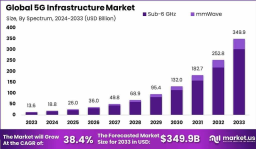

The global 5G infrastructure market is projected to reach USD 349.9 billion by 2033, up from USD 13.6 billion in 2023, registering a CAGR of 38.4%. This rapid growth is driven by expanding demand for high-speed connectivity, IoT integration, and digital transformation across industries. The adoption of 5G networks is reshaping telecom, manufacturing, healthcare, and smart city ecosystems, with APAC emerging as the leading region due to strong government initiatives, large-scale deployments, and early adoption. Increasing demand for ultra-low latency, higher bandwidth, and efficient spectrum utilization will continue to push infrastructure investment and accelerate global market expansion.
Key Takeaways
Market value to reach USD 349.9 billion by 2033.
CAGR of 38.4% during 2024–2033.
APAC held 42.1% share in 2023, USD 5.7 billion revenue.
Surge in IoT, AR/VR, and smart city projects driving demand.
Enhanced mobile broadband and edge computing adoption.
Dominant Market Position
APAC dominated the market in 2023, capturing 42.1% with USD 5.7 billion revenue. This dominance is supported by strong telecom infrastructure in China, Japan, and South Korea, coupled with government-backed 5G rollouts. The region benefits from large consumer bases, rapid urbanization, and high digital adoption, making it a hotspot for early 5G deployments. Strong investments in smart cities, industrial automation, and connected mobility also boost APAC’s leadership. North America follows closely, driven by private investments and strong demand for enterprise 5G solutions, while Europe emphasizes regulatory support and cross-border harmonization for accelerated infrastructure expansion.
Technology Perspective
5G infrastructure integrates small cells, macro cells, distributed antenna systems, and massive MIMO to deliver high-capacity, ultra-low-latency networks. Key enablers include mmWave spectrum, network slicing, and software-defined networking (SDN), enabling tailored connectivity for industries. Edge computing enhances real-time processing for applications like autonomous vehicles and remote surgery. Cloud-native architectures ensure scalability, while Open RAN supports vendor diversification and cost efficiency. Advanced chipsets and AI-driven network management optimize energy use and service reliability. With rapid IoT expansion and mission-critical applications, 5G technologies are evolving to support billions of devices, reshaping enterprise connectivity and accelerating digital transformation globally.
Dynamic Landscape
The market is highly competitive, with rapid investments in R&D, spectrum allocation, and infrastructure deployment. Strategic partnerships, mergers, and pilot rollouts are shaping competitive differentiation.
Drivers, Restraints, Opportunities, Challenges
Drivers: IoT proliferation, high data demand.
Restraints: High CAPEX, regulatory hurdles.
Opportunities: Smart cities, enterprise 5G adoption.
Challenges: Security risks, spectrum fragmentation.
Use Cases
Autonomous vehicles and connected mobility
Smart cities and infrastructure management
Remote healthcare and telemedicine
Industrial IoT and factory automation
AR/VR immersive experiences
Key Players Analysis
The competitive landscape features strong investments in R&D, partnerships with telecom operators, and large-scale infrastructure deployments. Players focus on enhancing network coverage, improving latency, and reducing costs through cloud-native solutions and open standards. Strategic collaborations with governments, enterprises, and cloud providers accelerate adoption. Vendors are innovating in mmWave, massive MIMO, and network slicing to meet diverse industry needs. Strong emphasis is placed on sustainability, with energy-efficient network solutions gaining traction. Companies are expanding through acquisitions and global alliances, positioning themselves as enablers of next-generation connectivity that supports digital ecosystems, smart cities, and mission-critical applications.
Recent Developments
Large-scale 5G deployments across APAC and North America.
Increased adoption of Open RAN architectures.
Strategic government spectrum auctions accelerating rollouts.
Expansion of edge computing integration with 5G.
Rising enterprise private 5G networks.
Conclusion
The 5G infrastructure market is set for exponential growth, driven by technological advancements, government support, and rising enterprise adoption. With APAC leading, the global race for 5G dominance will fuel innovation across industries, shaping a connected and digital future.
| No comments yet. Be the first. |